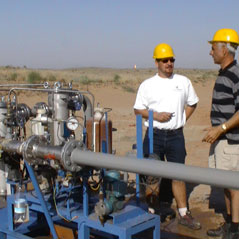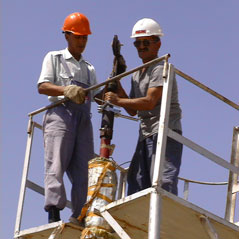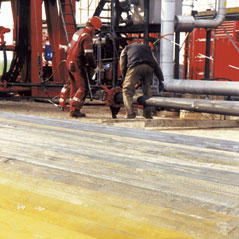Microbiological Investigations for underground gas storages, geothermal and other technical facilities
Microorganisms in reservoirs, underground storages and geothermal facilities may severely compromise quality of stored products, performance of technical equipment and operational safety.
Due to microbial activity, stored products may be affected by quality decrease, overall loss and souring through hydrogen sulphide. The performance of technical equipment, i.e. proper function and maintenance intervals, life-span and safety may be compromised by microbially influenced corrosion, acidification, clogging, deposits and foam formation.
Typical technical accident caused by micro-organisms:
- Degradation or alteration of stored products by microbial processes (degradation of hydrocarbons, e.g. ethylene, methane)
- Quality loss by generation of hydrogen sulphide, methane or carbon dioxide
- Microbially influenced corrosion (MIC) at pipelines, technical installations or sheet pile walls
- Plugging at wellbore bottomhole or surface installations, e.g. at filters or heat exchangers by microbial products (FeS) or biofilms
- Foam production or precipitation
- Collapse of drilling mud or other chemicals of drilling
In all cases, the investigations require a microbiological observation of the specific site conditions. Special and tested test media and processes guarantee a reliable analysis and typifying of the occurring organisms. Moreover, investigations of growth enable an application oriented, extensive characterisation of the proven bacteria population. These analyses are supplemented by modern molecular biological processes.
We offer you specially adapted microbiological investigations under conditions relevant to practice for samples containing water, oil or solids from technical units, drilled parts, probes, caverns or aquifer storage.
One focus of future work will form the evaluation and risk assessment in the underground storage of renewably generated hydrogen.
Services:
- Sampling of liquid and solid material from geologic structures or technical facilities
- Investigation of samples for all relevant micro-organisms
- Biochemical tests to quantify consumption of specific substances, e.g. hydrogen, hydrocarbons and production of critical components, e.g. hydrogen suphide
- Quantification of bacterial population and biochemical activity under specific field conditions (salinity, temperature, pressure ,chemical composition)
- Specification of bacterial groups with molecular and biochemical methods
- Root cause analysis of microbial growth and derivation of countermeasures
- Recommendations for stabilization of drilling mud or formation waters, efficacy testing of biocides
- Safety monitoring on gas storages by microbiological and geochemical analyses (soil gas tests)
- Expertises, risk assessment, scientific studies
We recommend conducting the investigation of your technical systems exclusively by experienced specialist staff using microbiologically founded sampling and user oriented, case specific laboratory analysis. We guarantee qualified investigations and competent advisory services – for more than 40 years – and look forward to working with you.
Case histories
Filter blockages on a geothermal system
Due to unexpected, critical increases in pressure in the circulation of a geothermal system, the material of a pump pre-filter was examined microbiologically. Evidence of liquid cultures and bacteria that recycled hydrogen and reduced sulphates (SRB) with high PCR content in the nucleus was found in the process. Growth tests with the accumulated bacteria cultures proved that the organisms only multiply at temperatures below 45°C, and thus cannot originate out of the warm heat circuit which is above 55°C. In fact, it had to do with bacteria that were dragged in from the cold water circuit.
The risk of an adaptation of the organisms to higher temperatures and the contamination of the warm water circuit associated with it was pointed out and suggestions for further measures were provided.
Stabilisation of drilling fluid for a drilled shaft
A drilled shaft with a 6 m diameter for a salt mine was to be sunk using a CMC drilling fluid (carboxy-methyl cellulose). Several 1,000 m³ of drilling fluid was stored in over ground basins. An intensive microbial CMC disintegration set in during the summer months. As a result, the drilling fluid could not be stabilized even through continuously high subsequent doses of CMC. The driller threatened to remain stuck due to the swelling clay in the drilled hole.
The result of extensive biocide tests showed that in the short term no preparation could be provided for this dimension.
Therefore an alkaline stabilisation of the drilled fluid was tested and suggested at a pH value of 11-12. The bacteria were thus effectively destroyed and the drill could be lowered safely without any further loss of fluid.Investigations during solution mining for gas storage
During a solution mining process for underground gas storage a heavy precipitation and flocculation with subsequent plugging occurred.
In water samples high cell numbers of various physiological groups of bacteria were detected. It was supposed that organic compounds (cellulosic substances), which have been injected with water into cavern serve as nutrient source. Microbial degradation processes obviously resulted in a high contamination, which has not been suppressed by high salt content of produced brine. Rather, it was demonstrated that during the solution mining process a salt resistant bacteria population established, which could grow on 245 g NaCl per litre.
It could be proven that slime-forming microorganisms were substantially involved in flocculation. As this process continues in simulated tests net-like structures developed containing filamentous bacteria. With increasing salt concentrations more complex filaments were produced. This correlation could be explained with emergence of new bacterial cell morphologies characterized by reduced mobility and disturbed cell division under physiological stress at high salinity.
As a result of microbiological investigations case-specific measures were recommended to reduce nutrient discharge and finally suppress bacteria.Investigation of corrosion effects on a pipeline
Corrosion damages on the outer wall of a natural gas pipeline within a swampy area have been detected by the operator. The pipeline was equipped with a cathodic corrosion protection.
A key factor for corrosion was initial process of hydrogen sulfide generation by sulfate reducing bacteria (SRB) which utilized the hydrogen jacket as energy source generated by cathodic corrosion protection. Hydrogen sulfide (H2S) produced by SRB reacted with iron ions dissolving from pipeline wall finally forming black iron sulfide (FeS). H2S and FeS are oxidized by several groups of sulfur oxidizing bacteria (SOB) to sulfuric acid and iron(II) sulfate. Specifically Acidithiobacillus ferrooxidans oxidizes iron(II) sulfate to Iron(III) salts. Starting from iron(II)sulfide (pyrite) substantial amounts of sulfuric acids will be produced in connection with water, which finally lead to an increased microbially influenced corrosion (MIC) of metal components.
As a result of extensive microbiological investigations the activity of bacteria involved and cause of the corrosion process have been determined.



